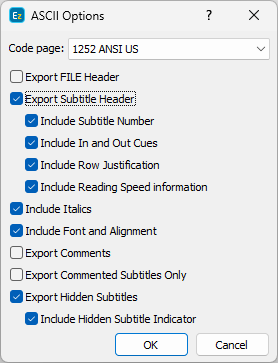Here you can specify which elements to include in the exported file. The EZTitles ASCII file structure is described in Appendix B. ASCII File Format used by EZTitles.

ASCII Export Configuration
First you need to select the encoding. Be sure to select the right encoding because otherwise some characters could be lost in the exported file. List of commonly used codepages is available at the end of this topic.
Export Subtitle Header |
Here you can select which elements to include in the subtitle header. The subtitle header is exported in the following format: <subtitle number> <in-cue> <out-cue> <justification> <reading speed> The reading speed information is the optimal number of characters calculated from the subtitle's duration and the reading speed parameters. |
Include Italics |
The italic text is surrounded by "<" and ">" in the exported file. Here you can select if you want to format it this way or export it as normal text. |
Include Font and Alignment |
The individual row alignment and the font number can be included at the beginning of each text line in the following form: [C1] that means centered row, font 1. |
Export Comments |
Export comment after the subtitle text. The comment lines begin with "##". |
Export FILE Header |
The file header adds some general information about the particular project like the information entered as File Details, video's frame rate, timecode format and the max. number of characters per row as defined at the Project Settings/Safe Area menu. |
Export Commented Subtitles Only |
Exports only the subtitles that have comments. |
Export Hidden Subtitles |
The hidden subtitles are normally discarded during the export. Here you can select to export them and also there is an option to include [hidden] tag at the end of the corresponding subtitle header. |
List of commonly used code pages:
1250 |
ANSI Eastern European: Central European and Eastern European languages that use Latin script, such as Polish, Czech, Slovak, Hungarian, Slovene, Croatian, Serbian (Latin script), Romanian, Albanian, etc. |
1251 |
ANSI Cyrillic |
1252 |
ANSI US - Western European languages (English, Spanish, German, French, Italian, etc.) |
1253 |
ANSI Greek |
1254 |
ANSI Turkish |
1257 |
ANSI Baltic, used for Estonian, Latvian and Lithuanian languages |
932 |
Japanese |
936 |
Chinese (RPC, Singapore) |
949 |
Korean |
950 |
Chinese (Taiwan, Hong Kong) |
1200 |
Unicode UTF-16. Not bound to any language. Combines characters in any of the world's writing systems. |
65001 |
Unicode UTF-8. Not bound to any language. Combines characters in any of the world's writing systems. |